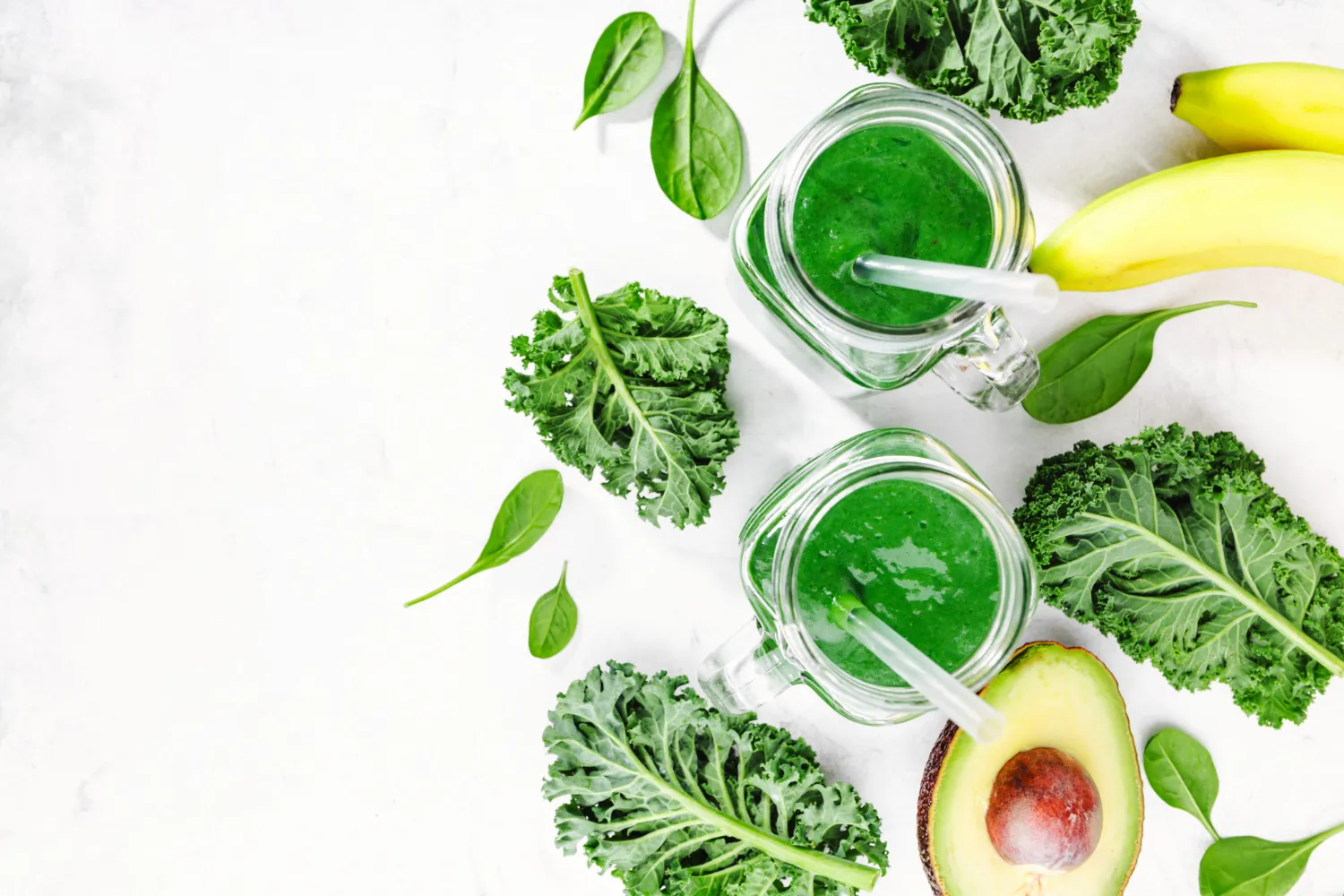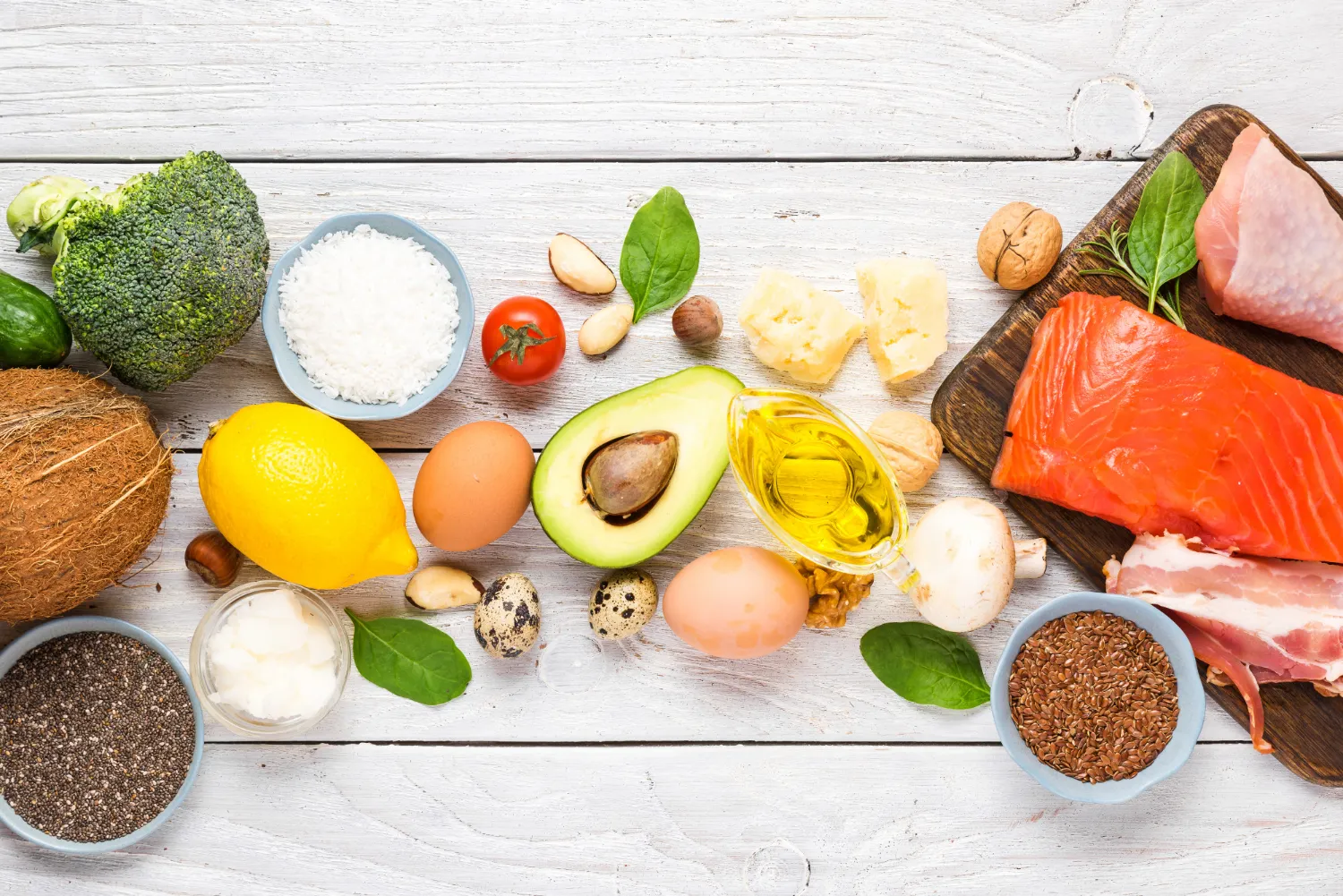Weight loss that fits your goals and your life.
Get your plan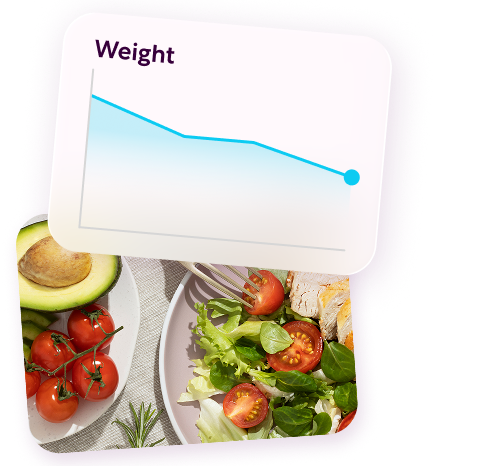
Weight loss that fits your goals and your life.
Get your plan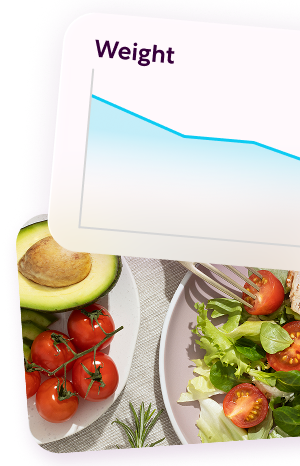
The decline of estrogen that women experience in their 40s leads to perimenopause, menopause, and symptoms that negatively impact quality of life and overall health.
One area of impact that raises serious concerns is cardiovascular health, as the decline of estrogen can lead to high blood pressure and increase the risk of cardiovascular disease.
Fortunately, nutrition plays a powerful role in reducing hypertension and preserving cardiovascular health, providing an accessible means of lowering cardiovascular risk.
In this article, we introduce the 7-day diet plan for high blood pressure in women. We display calorie and macronutrient recommendations, key ingredients, meal benefits, and lifestyle habits to lower blood pressure.
Nutritional Keys to Lowering Blood Pressure Naturally
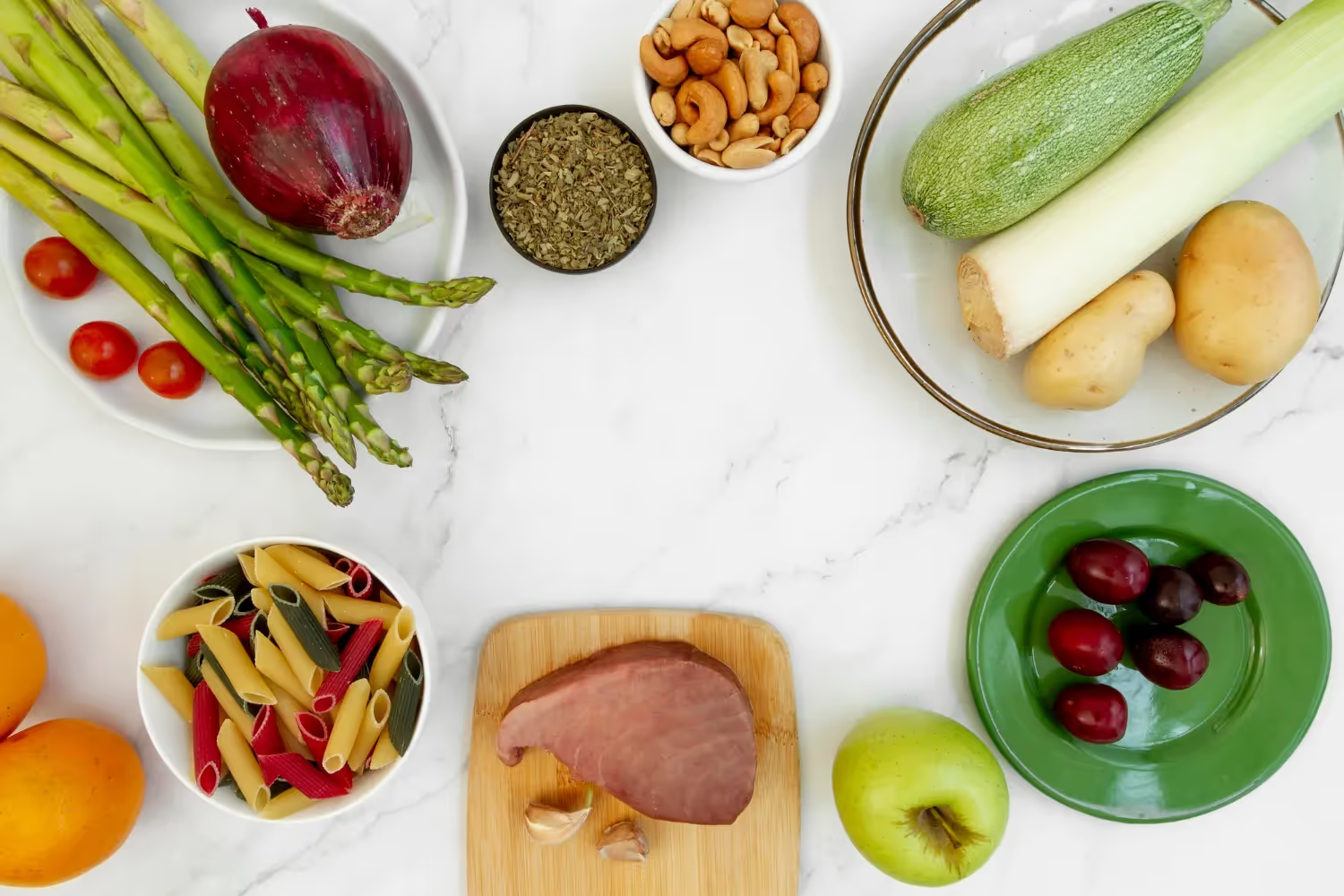
Research shows that high blood pressure and cardiovascular disease are much lower in premenopausal women compared to men, before elevating to similar levels during menopause, highlighting just how big of an impact declining estrogen levels can have on cardiovascular health.
High blood pressure is when blood pressure readings are equal to or exceed 140/90 mm Hg. When these levels are sustained, they are shown to contribute to comorbidities such as stroke, heart attack, heart failure, and renal failure.
Fortunately, eating a nutrient-dense diet can help support and preserve heart health. Below is a list of key nutrients that can help lower blood pressure and preserve cardiovascular health, including their food sources and benefits.
Your 7-Day Diet Plan for High Blood Pressure
This 7-day diet plan is designed to lower blood pressure. Each day contains three meals and one snack each day, and each contains blood pressure-lowering ingredients to help preserve your cardiovascular health.
To accompany this meal plan, we have added the recommended calorie and macronutrient intake. This is an example only; however, the formula is listed below so you can determine your daily calorie allowance.
BMR Formula
- BMR=10 × weight (kg) + 6.25 × height (cm) − 5 × age (years) −161
Using this formula, we will calculate the BMR for a 47-year-old woman, 80 kg, and 175 cm tall.
- 10 x 80 kg + 6.25 x 175 cm - 5 x 47 - 161
- 800 + 1093.75 - 235 - 161 = 1497.75 kcal/day
Macronutrient Ratio
- Carbohydrates: 50% of daily calorie intake
- Protein: 20% of daily calorie intake
- Fats: 30% of daily calorie intake
Day 1 — Leafy Greens and Whole Grains
Breakfast – Oats with Berries, Ground Flax, and Almond Butter (400 kcal)
- ½ cup rolled oats (150 kcal)
- ½ cup unsweetened almond milk (15 kcal)
- ½ banana, sliced (45 kcal)
- ½ cup blueberries (40 kcal)
- 1 tbsp ground flaxseed (35 kcal)
- ½ scoop plant-based protein powder (60 kcal)
- 1 tbsp almond butter (55 kcal)
Benefits: This fiber-rich breakfast helps reduce blood pressure by promoting nitric oxide production and reducing arterial stiffness, thanks to oats, flax, and berries.
Lunch – Quinoa Salad with Kale, Chickpeas, Avocado, and Lemon-Tahini (400 kcal)
- ½ cup cooked quinoa (110 kcal)
- ½ cup cooked chickpeas (120 kcal)
- 1 cup chopped kale, lightly massaged (20 kcal)
- ¼ avocado (60 kcal)
- 1 tbsp tahini (90 kcal)
Benefits: Packed with potassium and magnesium from kale and avocado, plus plant protein and whole grains, this lunch supports healthy circulation and keeps sodium in balance.
Dinner – Brown Rice Stir Fry with Spinach, Bell Peppers, Tofu, and Olive Oil (400 kcal)
- ½ cup cooked brown rice (110 kcal)
- ½ block firm tofu, cubed (90 kcal)
- ½ cup chopped spinach (10 kcal)
- ½ cup red bell pepper, sliced (25 kcal)
- 1 tsp olive oil (40 kcal)
- ½ tsp low-sodium soy sauce or coconut aminos (5 kcal)
- ½ scoop plant protein or sprinkle of hemp seeds (60 kcal)
- ¼ cup edamame (60 kcal)
Benefits: This vibrant dinner includes potassium-rich vegetables, heart-healthy fats, and plant protein, all supporting reduced vascular resistance and better endothelial function.
Snack – Chia Pudding with Berries and Walnuts (300 kcal)
- 2 tbsp chia seeds (120 kcal)
- ½ cup unsweetened almond milk (15 kcal)
- ½ cup mixed berries (40 kcal)
- 1 tbsp chopped walnuts (45 kcal)
- ½ scoop plant-based protein powder (60 kcal)
- Dash of cinnamon (0 kcal)
- ½ tsp honey or maple syrup (20 kcal)
Benefits: Chia seeds, berries, and walnuts provide a trifecta of omega-3s, antioxidants, and fiber—all of which can reduce blood pressure and inflammation.
Day 2 — High Potassium from Sweet Potatoes & Lentils
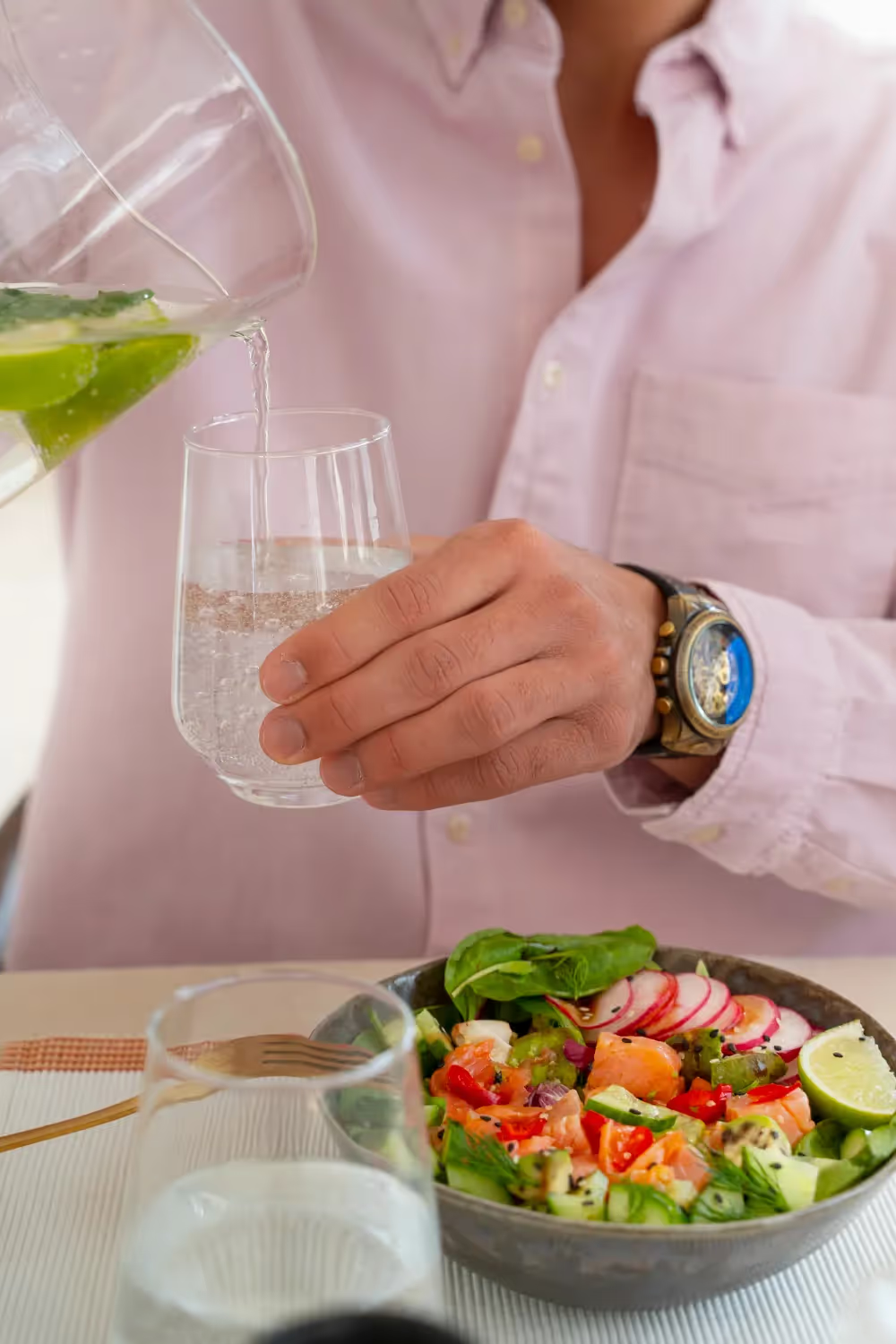
Breakfast – Sweet Potato Breakfast Bowl with Yogurt and Almonds (400 kcal)
- ½ medium sweet potato, roasted and cubed (90 kcal)
- ½ banana, sliced (45 kcal)
- ½ cup plain Greek yogurt (low-fat) (90 kcal)
- 1 tbsp almond butter (95 kcal)
- 1 tbsp chopped almonds (60 kcal)
- Sprinkle of cinnamon (0 kcal)
- ½ tsp drizzle of maple syrup (20 kcal)
Benefits: Sweet potatoes and bananas deliver a potassium punch to help lower blood pressure, while yogurt adds probiotics and protein for a balanced gut start.
Lunch – Lentil Salad with Roasted Sweet Potato and Spinach (400 kcal)
- ¾ cup cooked green lentils (150 kcal)
- ½ medium roasted sweet potato (90 kcal)
- 1 cup baby spinach –(10 kcal)
- ¼ avocado, diced (60 kcal)
- 1 tbsp olive oil (120 kcal)
- Squeeze of lemon + herbs (0 kcal)
Benefits: Lentils are a potassium-rich legume that supports heart health, and this lunch includes fiber, magnesium, and healthy fats—all key to blood pressure regulation.
Dinner – Warm Lentil & Sweet Potato Stew with Kale and Olive Oil (400 kcal)
- ¾ cup cooked lentils (150 kcal)
- ½ cup diced sweet potato (90 kcal)
- ½ cup kale, chopped (15 kcal)
- 1 tsp olive oil (for sautéing garlic/onions) (40 kcal)
- ½ cup low-sodium vegetable broth (10 kcal)
- 1 tbsp ground flaxseed (stirred in at end) (55 kcal)
- Dash of cumin and black pepper (0 kcal)
- ½ tbsp nutritional yeast (40 kcal)
Benefits: This hearty stew combines resistant starches, potassium, fiber, and anti-inflammatory greens, helping your blood vessels relax and function better overnight.
Snack – Sweet Potato & Lentil Hummus with Veggie Sticks and Walnuts (300 kcal)
- ¼ cup cooked lentils – (50 kcal)
- ¼ cup mashed sweet potato (45 kcal)
- ½ tbsp tahini (45 kcal)
- 1 tsp olive oil (40 kcal)
- 1 cup raw carrot and cucumber sticks (25 kcal)
- 1 tbsp chopped walnuts (70 kcal)
- Garlic, lemon juice, cumin for flavor (0 kcal)
- 1 Wasa or seed cracker (optional) (25 kcal)
Benefits: A savory, fiber-rich snack full of blood pressure–friendly nutrients and crunch, this combo stabilizes blood sugar while flooding your body with potassium and magnesium.
Day 3 — Magnesium-Rich Nuts, Seeds, and Beans
Breakfast – Oats with Chia, Almonds, and Cinnamon-Spiced Black Beans (400 kcal)
- ⅓ cup rolled oats (110 kcal)
- ⅓ cup cooked black beans (75 kcal)
- ¾ cup unsweetened almond milk (15 kcal)
- 1 tbsp chia seeds (60 kcal)
- ½ medium banana (sliced) (45 kcal)
- 1 tbsp Almonds (chopped) (70 kcal)
- Ground cinnamon + pinch of sea salt (0 kcal)
- ½ tsp drizzle of maple syrup (25 kcal)
Benefits: This high-fiber breakfast combines soluble fiber and plant protein with minerals like magnesium and potassium, critical for managing blood pressure.
Lunch – Chickpea and Quinoa Salad with Sunflower Seeds and Lemon-Tahini Dressing (400 kcal)
- ½ cup cooked quinoa (110 kcal)
- ½ cup cooked chickpeas (135 kcal)
- 1 cup baby spinach (10 kcal)
- ½ cup cherry tomatoes (15 kcal)
- 1 tbsp sunflower seeds (55 kcal)
- 1 tsp tahini (30 kcal)
- 1 tsp olive oil (40 kcal)
- Lemon juice and cumin (0 kcal)
- Fresh parsley (5 kcal)
Benefits: Beans, seeds, and greens come together in a nutrient-packed bowl that supports healthy arteries and delivers plenty of fiber and unsaturated fats.
Dinner – Spiced Bean and Veggie Stir-Fry with Brown Rice and Pumpkin Seeds (400 kcal)
- ½ cup cooked brown rice (110 kcal)
- ½ cup total mixed cooked kidney and black beans (110 kcal)
- 1 cup total sautéed bell peppers, zucchini, and kale (40 kcal)
- 1 tbsp pumpkin seeds (60 kcal)
- 1 tsp olive oil (for cooking) (40 kcal)
- Garlic, turmeric, cumin, and black pepper (0 kcal)
- Splash of low-sodium tamari or coconut aminos (40 kcal)
Benefits: This colorful dinner features beans for potassium and fiber, seeds for heart-healthy fats, and anti-inflammatory spices to round out a blood pressure–supportive meal.
Snack – Seed and Nut Energy Bowl with Berries and Dark Chocolate (300 kcal)
- ½ cup mixed berries (35 kcal)
- 1 tbsp walnuts (chopped) (70 kcal)
- 1 tbsp ground flaxseed (55 kcal)
- 1 tbsp hemp seeds (55 kcal)
- ½ cup plain soy or almond yogurt (60 kcal)
- 1 small square – 5g dark chocolate (85%) (25 kcal)
Benefits: This snack delivers polyphenols, omega-3s, and antioxidants that support vascular function while offering a satisfying crunch and a touch of sweetness.
Day 4 — DASH-Friendly Plant and Protein Balance
Breakfast – Spinach & Sweet Potato Bowl with Low-Fat Cottage Cheese and Olive Oil Drizzle (400 kcal)
- ½ cu roasted sweet potato (cubed) (90 kcal)
- ¾ cup steamed spinach (20 kcal)
- ½ cup low-fat cottage cheese (90 kcal)
- ¼ cup cooked quinoa (55 kcal)
- 1 tsp olive oil (40 kcal)
- ½ cup sliced strawberries (25 kcal)
- 1 tsp chia seeds (30 kcal)
- Sprinkle of cinnamon and black pepper (0 kcal)
- Squeeze of lemon (0 kcal)
Benefits: This savory-sweet combo provides potassium, calcium, and magnesium—the DASH trifecta—along with fiber, slow carbs, and protein to support balanced blood pressure throughout the day.
Lunch – Lentil & Avocado Grain Bowl with Cucumber and Yogurt-Tahini Dressing (400 kcal)
- ½ cup cooked green lentils (115 kcal)
- Cooked farro or bulgur (100 kcal)
- ½ cup cucumber slices (8 kcal)
- ¼ medium sliced avocado (60 kcal)
- 2 tbsp plain low-fat Greek yogurt (30 kcal)
- 1 tsp tahini (30 kcal)
- Lemon juice, garlic, parsley (0 kcal)
- 1 cup arugula or mixed greens (10 kcal)
- 1 tsp pumpkin seeds (20 kcal)
- 1 tsp olive oil (40 kcal)
Benefits: This bowl is packed with fiber, plant protein, healthy fats, and DASH-aligned potassium- and magnesium-rich ingredients that help relax blood vessels and support steady circulation.
Dinner – Herbed Chicken with Steamed Broccoli, Wild Rice, and Sunflower Seeds (400 kcal)
- 3 oz grilled chicken breast (130 kcal)
- 1 cup steamed broccoli (35 kcal)
- ½ cup cooked wild rice (85 kcal)
- 1 tsp olive oil (40 kcal)
- 1 tsp sunflower seeds (20 kcal)
- Lemon zest, rosemary, black pepper (0 kcal)
- ¼ cup grated raw carrot (12 kcal)
- ¼ cup red bell pepper (10 kcal)
- ¼ cup diced cucumber (8 kcal)
- 1 tbsp plain yogurt (optional topping) (10 kcal)
Benefits: Dinner combines lean protein with fiber-rich vegetables and whole grains, enhancing satiety while delivering blood pressure–lowering nutrients like potassium and antioxidants from plant pigments.
Snack – Berry-Chia Yogurt Bowl with Walnuts and Flax (300 kcal)
- ½ cup plain low-fat Greek yogurt (60 kcal)
- ¾ cup mixed berries (45 kcal)
- 1 tbsp ground flaxseed (55 kcal)
- 1 tbsp, chopped walnuts (70 kcal)
- 1 tsp chia seeds (30 kcal)
- Cinnamon and vanilla extract (0 kcal)
- 1–2 tbsp splash of unsweetened almond milk (10 kcal)
- ½ tsp drizzle of honey or maple (30 kcal)
Benefits: This snack combines prebiotic fiber and plant omega-3s with antioxidant-rich berries and protein, helping to curb inflammation and promote cardiovascular balance.
Day 5 — Omega-3s with Fatty Fish and Flax
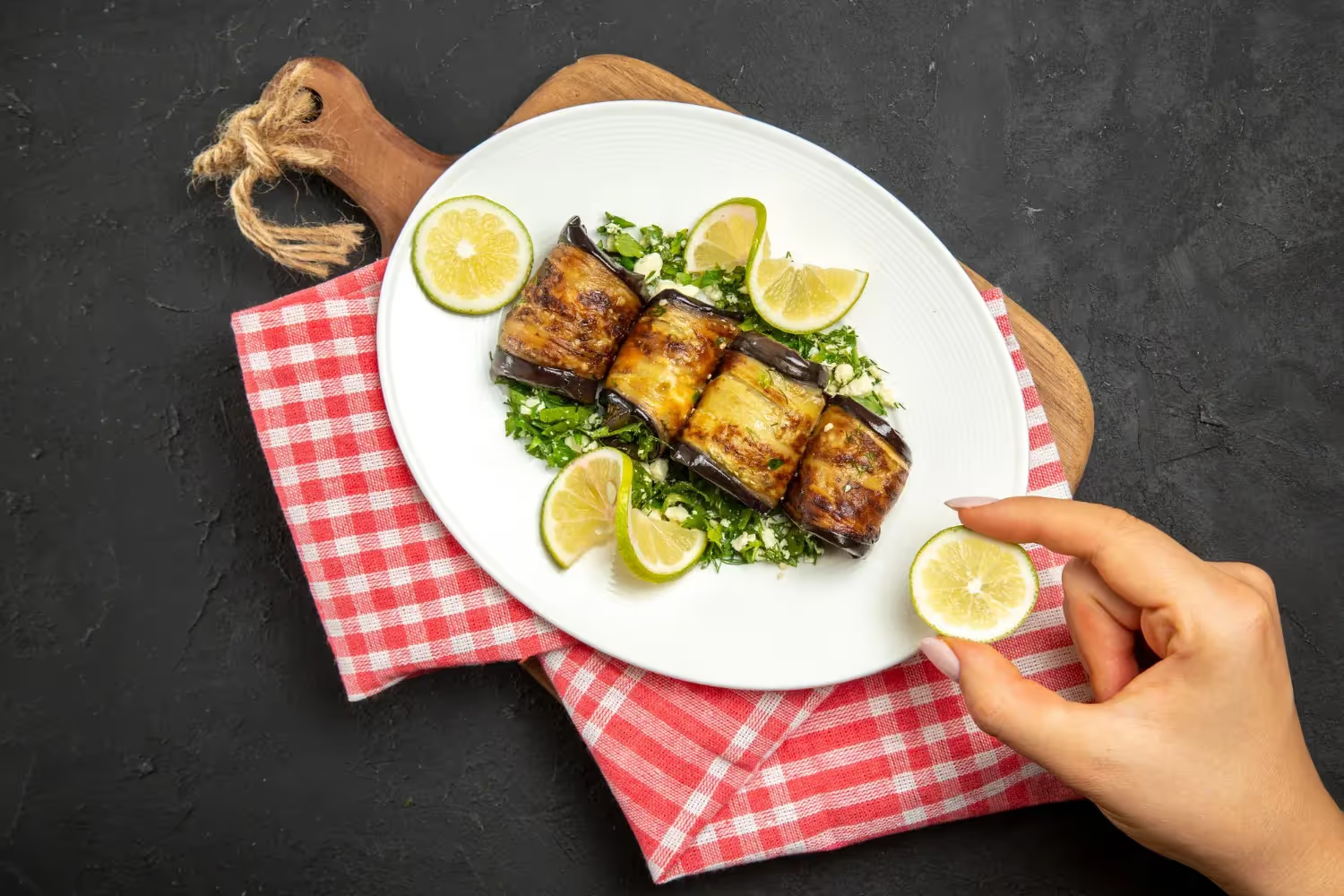
Breakfast – Flax & Berry Oats with Almond Butter and Chia (400 kcal)
- ½ cup rolled oats (150 kcal)
- 1 tbsp ground flaxseed (55 kcal)
- 1 tsp chia seeds (30 kcal)
- ¾ cup unsweetened almond milk (25 kcal)
- ½ cup blueberries (40 kcal)
- 1 tsp almond butter (35 kcal)
- ¼ cup plain low-fat Greek yogurt (stirred in) (40 kcal)
- Cinnamon and a splash of vanilla extract (0 kcal)
Benefits: This creamy, fiber-packed bowl delivers plant omega-3s, potassium, and antioxidants—all key players in lowering inflammation and supporting vascular relaxation.
Lunch – Salmon & Quinoa Salad with Greens, Flax Oil & Lemon (400 kcal)
- ½ cup cooked quinoa (110 kcal)
- 3 oz wild canned salmon (120 kcal)
- 1 cup arugula or baby spinach (10 kcal)
- ½ cup total sliced cucumber and red bell pepper (20 kcal)
- ¼ cup cherry tomatoes (10 kcal)
- 1 tsp flaxseed oil (45 kcal)
- Lemon juice and zest (0 kcal)
- Chopped parsley (0 kcal)
- 1 tsp pumpkin seeds (20 kcal)
- Cracked pepper and pinch of sea salt – (0 kcal)
Benefits: This salad blends marine and plant-based omega-3s with potassium- and nitrate-rich veggies for blood vessel support, plus quality protein and slow-burning carbs for sustained energy.
Dinner – Roasted Sweet Potato & Veggie Bowl with Sardines and Tahini Yogurt Sauce (400 kcal)
- ½ cup cubes roasted sweet potato (90 kcal)
- ¾ cup steamed kale or spinach (25 kcal)
- 1 small can, ~3 oz drained Sardines in water (120 kcal)
- ⅓ cup cooked brown rice (75 kcal)
- 2 tbsp plain low-fat Greek yogurt (30 kcal)
- 1 tsp tahini (30 kcal)
- Garlic, lemon juice, cumin for sauce (0 kcal)
- 1–2 tbsp each chopped celery and red onion (10 kcal)
- ½ tsp olive oil (20 kcal)
Benefits: Rich in omega-3s, calcium, fiber, and potassium, this savory bowl supports both heart and digestive health while balancing blood sugar and inflammation.
Snack – Yogurt & Flax Parfait with Walnuts and Dark Chocolate Shavings (300 kcal)
- ½ cup plain low-fat Greek yogurt (60 kcal)
- 1 tbsp ground flaxseed (55 kcal)
- 1 tbsp chopped walnuts (70 kcal)
- ½ cup raspberries (30 kcal)
- ½ medium banana slices (45 kcal)
- 1 small square grated Dark chocolate (85%) (30 kcal)
- Cinnamon and nutmeg (0 kcal)
- Optional: ½ tsp drizzle of honey (10 kcal)
Benefits: This creamy, crunchy, antioxidant-rich treat promotes satiety, supports healthy cholesterol levels, and satisfies sweet cravings while contributing key nutrients for cardiovascular and metabolic wellness.
Day 6 — Low-Sodium, High-Flavor Day
Breakfast – Citrus Quinoa Bowl with Fresh Berries and Toasted Nuts (400 kcal)
- ½ cup cooked quinoa (110 kcal)
- ½ cup unsweetened almond milk (20 kcal)
- 1 tbsp ground flaxseed (55 kcal)
- ½ medium fresh orange segments (30 kcal)
- ½ cup blueberries (40 kcal)
- 1 tbsp slivered almonds (lightly toasted) (70 kcal)
- ¼ cup plain low-fat Greek yogurt (40 kcal)
- Cinnamon and orange zest (0 kcal)
- 1 tsp drizzle of maple syrup (35 kcal)
Benefits: Naturally sweet and citrus-bright, this fiber- and potassium-rich breakfast supports healthy vessels and keeps sodium minimal while providing complete plant protein.
Lunch – Roasted Veggie Lentil Salad with Lemon-Tahini Dressing (400 kcal)
- ½ cup cooked green lentils (115 kcal)
- ½ cup roasted sweet potato (cubes) (90 kcal)
- 1 cup baby spinach (10 kcal)
- ½ cup total chopped cucumber and red bell pepper (20 kcal)
- ¼ cup cherry tomatoes (10 kcal)
- 1 tsp tahini (30 kcal)
- Lemon juice, garlic, cumin, and apple cider vinegar (for dressing) (0 kcal)
- 1 tsp olive oil (45 kcal)
- Chopped parsley and mint (0 kcal)
- 1 tsp pumpkin seeds (20 kcal)
Benefits: This lunch delivers bold flavors with citrus, herbs, and tahini while offering potassium, magnesium, and fiber—all powerful for lowering blood pressure without adding salt.
Dinner – Herbed Brown Rice Bowl with Chickpeas, Avocado & Citrus Slaw (400 kcal)
- ½ cup cooked brown rice (110 kcal)
- ½ cup cooked chickpeas (135 kcal)
- ½ cup shredded red cabbage (15 kcal)
- ¼ cup grated carrot (10 kcal)
- ¼ medium avocado (60 kcal)
- 1 tsp olive oil (45 kcal)
- Fresh lime juice, garlic, and chopped cilantro (0 kcal)
- Cracked pepper and chili flakes (0 kcal)
- 1 tsp toasted sunflower seeds (25 kcal)
Benefits: A high-flavor, low-sodium bowl full of color and crunch, rich in antioxidants, healthy fats, and fiber to reduce vascular stress and inflammation naturally.
Snack – Savory Yogurt Bowl with Walnuts, Flax, and Pomegranate (300 kcal)
- ½ cup plain low-fat Greek yogurt (60 kcal)
- 1 tbsp ground flaxseed (55 kcal)
- 1 tbsp chopped walnuts (70 kcal)
- ¼ cup pomegranate seeds (35 kcal)
- ¼ cup cucumber (finely diced) (5 kcal)
- Lemon juice and sumac spice (0 kcal)
- ½ tsp olive oil drizzle (20 kcal)
- Sliced radish and fresh dill (optional) (0 kcal)
- 1 piece whole grain cracker (55 kcal)
Benefits: This Mediterranean-style bowl mixes creamy, crunchy, tangy, and sweet with no added salt—perfect for flavor and heart health with a polyphenol boost.
Day 7 — Blood Pressure Friendly Variety
Breakfast – Oatmeal Bowl with Banana, Chia, and Berries (400 kcal)
- ½ cup rolled oats (150 kcal)
- ¾ cup unsweetened almond milk (30 kcal)
- ½ medium sliced banana (50 kcal)
- ¼ cup blueberries (20 kcal)
- 1 tbsp ground chia seeds (60 kcal)
- 1 tsp natural peanut butter (30 kcal)
- ¼ cup plain low-fat Greek yogurt (stirred in) (40 kcal)
- 1 tsp cinnamon and flaxseed (20 kcal)
Benefits: This breakfast delivers soluble fiber, potassium, and magnesium, all of which support relaxed blood vessels and steady blood pressure—all without adding salt or sugar.
Lunch – Lentil Quinoa Bowl with Roasted Veggies and Lemon-Herb Dressing (400 kcal)
- ½ cup cooked green lentils (115 kcal)
- ½ cup cooked quinoa (110 kcal)
- ½ cup roasted carrots and red bell pepper (50 kcal)
- ½ cup steamed kale (20 kcal)
- 1 tsp olive oil (in dressing) (45 kcal)
- Lemon juice, garlic, Dijon mustard (1 tsp), black pepper (0 kcal)
- Chopped parsley (0 kcal)
- 1 tbsp pumpkin seeds (60 kcal)
Benefits: This meal brings together blood pressure–friendly nutrients like plant protein, potassium, and antioxidants in a fiber-rich bowl with tangy, low-sodium zest.
Dinner – Baked Salmon with Sweet Potato Mash and Garlicky Greens (400 kcal)
- 3 oz baked salmon (150 kcal)
- ½ cup mashed sweet potato (100 kcal)
- 1 cup steamed spinach with garlic (30 kcal)
- 1 tsp olive oil (for sauté) (45 kcal)
- Lemon juice and thyme (0 kcal)
- ¼ cup cooked farro or brown rice (75 kcal)
Benefits: Salmon provides omega-3 fats that help reduce inflammation and improve blood vessel elasticity, paired with potassium-rich sides for total heart support.
Snack – Yogurt-Parfait with Flax, Walnuts, and Pomegranate (300 kcal)
- ½ cup plain low-fat Greek yogurt (60 kcal)
- 1 tbsp ground flaxseed (55 kcal)
- 1 tbsp chopped walnuts (70 kcal)
- ¼ cup pomegranate seeds (35 kcal)
- 2 tbsp rolled oats (50 kcal)
- Dash of cinnamon (0 kcal)
- ¼ cup frozen raspberries (30 kcal)
Benefits: This snack balances prebiotic fiber, healthy fats, and polyphenols—all known to enhance vascular health and lower blood pressure, naturally and deliciously.
Lifestyle Habits to Support Lower Blood Pressure
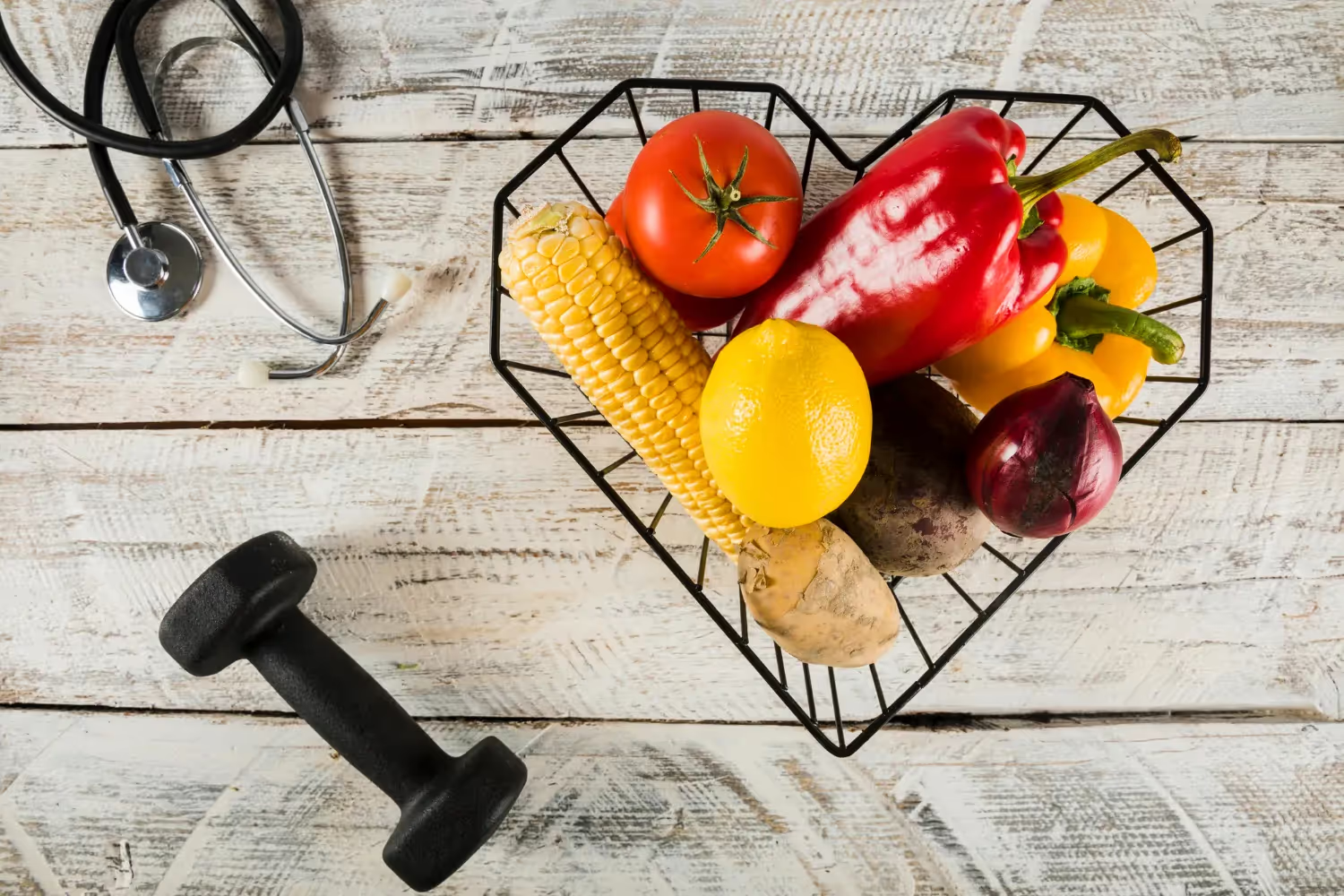
Adjusting your nutrition is a powerful way to lower blood pressure. However, if you want to make an even greater impact, you must change your lifestyle. Below is a list of ways to lower blood pressure.
Movement, Stress, and Sleep Synergy
It is understood that a sedentary lifestyle, life stressors, and poor sleep are linked to elevated blood pressure.
A 2015 study showed that those with greater sedentary time exhibited 4.36 mmHg higher systolic blood pressure.
Sources indicate that poor sleep, including short sleep duration, trouble sleeping, and sleep disorders, is linked to hypertension. Meanwhile, evidence indicates that prolonged and ongoing stress has been associated with elevated blood pressure and hypertension.
Fortunately, interventions such as exercise, mindfulness practices, and quality sleep can be used to lower blood pressure.
Studies show that exercise can lower systolic and diastolic blood pressure with a 5–7 mmHg reduction for individuals with hypertension, with acute exercise being linked to a reduction in systolic blood pressure.
While research shows that during sleep out there is a natural decline in blood pressure, heart rate, and cardiac output, which is vital for cardiovascular health. Quality sleep of 7–9 hours each night is also associated with stress hormone regulation and emotional regulation.
Combined with mindfulness practices that are shown to reduce blood pressure, improve mental health, and quality of life.
Reducing Caffeine and Alcohol Sensibly
Caffeine and alcohol both have the potential to increase blood pressure and even cause chronic hypertension.
Caffeine intake is typically a healthy practice. However, it has been shown to increase blood pressure, which may pose a risk for those experiencing chronic hypertension. Meanwhile, acute alcohol consumption is shown to cause elevated blood pressure, with long-term consumption leading to chronic hypertension.
Research shows that the caffeine toxicity threshold is 400 mg/day, which is the equivalent of four cups of coffee. Reducing this to at least 200 mg/day would be recommended to avoid blood pressure increases.
Meanwhile, the recommended amount of alcohol is none; we understand this is unrealistic. Sources recommend that one drink per day or fewer than 10 standard drinks a week is needed to reduce the risk of harm and alcohol related diseases.
Using Food Journals to Spot Triggers
Journaling your food intake and noting your triggers is a powerful way to gain control of your blood sugar.
Identifying potential triggers for high blood pressure can be challenging in the beginning; however, with practice, you will be able to identify the symptoms. These include:
- Shortness of breath
- Dizziness
- Headaches
- Nausea
- Flush
- Fatigue
- Irregular heartbeat
- Anxiety
Linking the symptoms you are experiencing with different foods can help you identify which ones are helping and which are harming your blood pressure levels.
Recap — What This 7 Day Blood Pressure Plan Supports
The increase in blood pressure that women experience as they enter their 40s and estrogen declines can lead to significant health problems, including heart attack, heart failure, stroke, kidney failure, and vision loss.
Fortunately, there are several things you can change right now to lower blood pressure and improve long-term health, such as diet, exercise, improving sleep, and lowering stress.
Nutrient Balance for Vascular Health
Balancing nutrients is vital for maintaining vascular health. Nutrients, including omega-3 fatty acids, improve arterial health, fiber helps lower cholesterol, and vitamins C and E are antioxidants that protect blood vessels from damage.
Reduced Sodium, Elevated Potassium
Sodium has been associated with blood pressure and cardiovascular events, while potassium has a preventative effect on blood pressure and cardiovascular disease.
Therefore, by reducing sodium intake in favour of potassium-rich foods such as bananas, spinach, sweet potato, yogurt, avocado, and beans, you can begin supporting your cardiovascular system.
Long-Term Cardiovascular Support for Women
Long-term cardiovascular support requires a holistic approach. More than just diet, elements including exercise, sleep, and stress levels must be modified to give you the best chance of improving your blood pressure and cardiovascular health.
While each one has a significant impact on our health, combined, they can not only improve your cardiovascular health, but also improve your quality of life.
Weight loss that fits your goals and your life.
Get your plan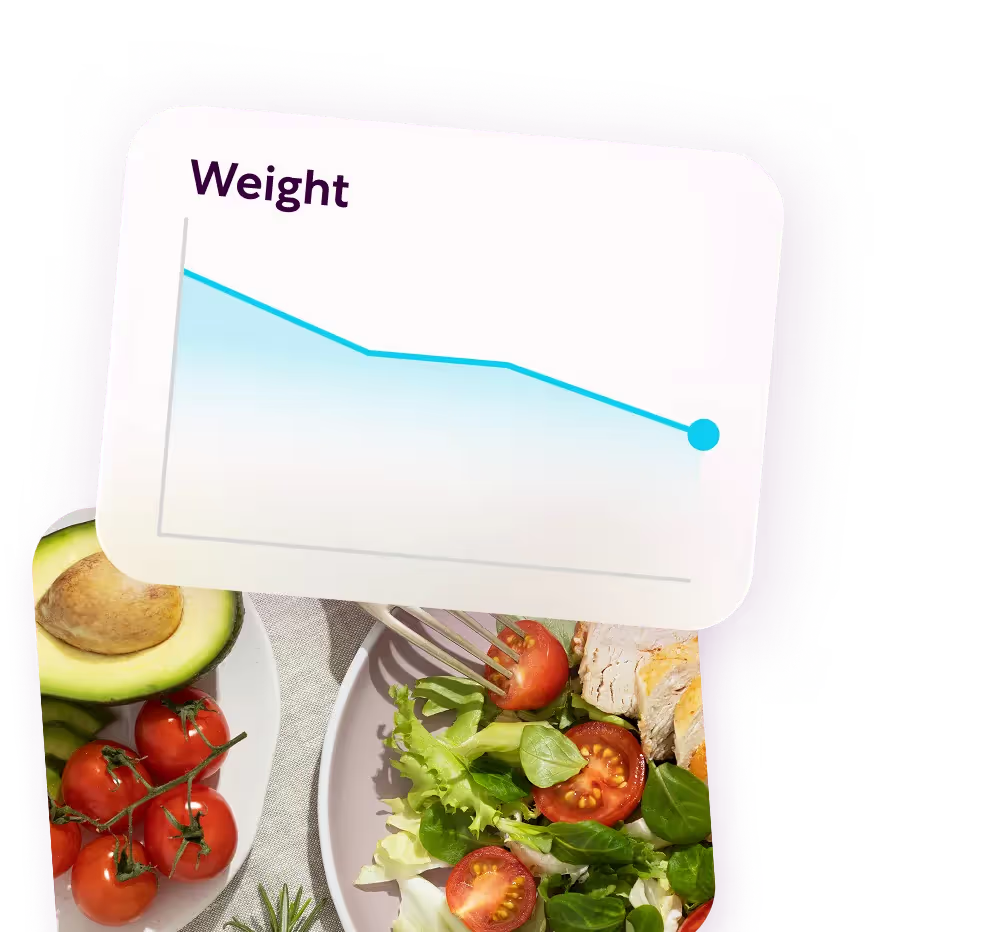
Sources
- Wyss JM, Carlson SH. Effects of hormone replacement therapy on the sympathetic nervous system and blood pressure. Curr Hypertens Rep. 2003 Jun;5(3):241-6. doi: 10.1007/s11906-003-0027-8. PMID: 12724057. https://pubmed.ncbi.nlm.nih.gov/12724057/
- Iqbal, A.M. and Jamal, S.F., 2023. Essential Hypertension. StatPearls [Internet]. Treasure Island (FL): StatPearls Publishing. Available at: https://www.ncbi.nlm.nih.gov/books/NBK539859/
- Filippini T, Naska A, Kasdagli MI, Torres D, Lopes C, Carvalho C, Moreira P, Malavolti M, Orsini N, Whelton PK, Vinceti M. Potassium Intake and Blood Pressure: A Dose-Response Meta-Analysis of Randomized Controlled Trials. J Am Heart Assoc. 2020 Jun 16;9(12):e015719. doi: 10.1161/JAHA.119.015719. Epub 2020 Jun 5. PMID: 32500831; PMCID: PMC7429027. https://pmc.ncbi.nlm.nih.gov/articles/PMC7429027/
- Alharran, A.M., Alzayed, M.M., Jamilian, P., Prabahar, K., Kamal, A.H., Alotaibi, M.N., Elshaer, O.E., Alhatm, M., Masmoum, M.D., Hernández-Wolters, B., Sindi, R., Kord-Varkaneh, H. and Abu-Zaid, A., 2024. Impact of magnesium supplementation on blood pressure: An umbrella meta-analysis of randomized controlled trials. Current Therapeutic Research, 101, p.100755. https://doi.org/10.1016/j.curtheres.2024.100755. https://www.sciencedirect.com/science/article/abs/pii/S0939475317302223
- Villa-Etchegoyen C, Lombarte M, Matamoros N, Belizán JM, Cormick G. Mechanisms Involved in the Relationship between Low Calcium Intake and High Blood Pressure. Nutrients. 2019 May 18;11(5):1112. doi: 10.3390/nu11051112. PMID: 31109099; PMCID: PMC6566648. https://pmc.ncbi.nlm.nih.gov/articles/PMC6566648/
- Khan, K., Jovanovski, E., Ho, H.V.T., Marques, A.C.R., Zurbau, A., Mejia, S.B., Sievenpiper, J.L. and Vuksan, V., 2018. The effect of viscous soluble fiber on blood pressure: A systematic review and meta-analysis of randomized controlled trials. Nutrition, Metabolism and Cardiovascular Diseases, 28(1), pp.3–13. https://doi.org/10.1016/j.numecd.2017.10.010. https://www.sciencedirect.com/science/article/abs/pii/S0939475317302223
- National Institutes of Health Office of Dietary Supplements, 2023. Omega-3 fatty acids: Fact sheet for health professionals. [online] National Institutes of Health. Available at: https://ods.od.nih.gov/factsheets/Omega3FattyAcids-HealthProfessional/
- Hegde SM, Solomon SD. Influence of Physical Activity on Hypertension and Cardiac Structure and Function. Curr Hypertens Rep. 2015 Oct;17(10):77. doi: 10.1007/s11906-015-0588-3. PMID: 26277725; PMCID: PMC4624627. https://pmc.ncbi.nlm.nih.gov/articles/PMC4624627/
- Li C, Shang S. Relationship between Sleep and Hypertension: Findings from the NHANES (2007-2014). Int J Environ Res Public Health. 2021 Jul 25;18(15):7867. doi: 10.3390/ijerph18157867. PMID: 34360157; PMCID: PMC8345503. https://pmc.ncbi.nlm.nih.gov/articles/PMC8345503/
- Sohn MW, Manheim LM, Chang RW, Greenland P, Hochberg MC, Nevitt MC, Semanik PA, Dunlop DD. Sedentary behavior and blood pressure control among osteoarthritis initiative participants. Osteoarthritis Cartilage. 2014 Sep;22(9):1234-40. doi: 10.1016/j.joca.2014.07.007. Epub 2014 Jul 18. PMID: 25042550; PMCID: PMC4159385. https://pmc.ncbi.nlm.nih.gov/articles/PMC4159385/
- Stults-Kolehmainen MA, Sinha R. The effects of stress on physical activity and exercise. Sports Med. 2014 Jan;44(1):81-121. doi: 10.1007/s40279-013-0090-5. PMID: 24030837; PMCID: PMC3894304. https://pmc.ncbi.nlm.nih.gov/articles/PMC3894304/
- Bock JM, Vungarala S, Covassin N, Somers VK. Sleep Duration and Hypertension: Epidemiological Evidence and Underlying Mechanisms. Am J Hypertens. 2022 Jan 5;35(1):3-11. doi: 10.1093/ajh/hpab146. PMID: 34536276; PMCID: PMC8730491. https://pmc.ncbi.nlm.nih.gov/articles/PMC8730491/
- Babak A, Motamedi N, Mousavi SZ, Ghasemi Darestani N. Effects of Mindfulness-Based Stress Reduction on Blood Pressure, Mental Health, and Quality of Life in Hypertensive Adult Women: A Randomized Clinical Trial Study. J Tehran Heart Cent. 2022 Jul;17(3):127-133. doi: 10.18502/jthc.v17i3.10845. PMID: 37252082; PMCID: PMC10222936. https://pmc.ncbi.nlm.nih.gov/articles/PMC10222936/
- Xu, Z., Meng, Q., Ge, X., Zhuang, R., Liu, J., Liang, X., Fan, H., Yu, P., Zheng, L. and Zhou, X., 2021. A short-term effect of caffeinated beverages on blood pressure: A meta-analysis of randomized controlled trials. Journal of Functional Foods, 81, p.104482. https://doi.org/10.1016/j.jff.2021.104482. https://www.sciencedirect.com/science/article/pii/S1756464621001316
- Tasnim S, Tang C, Musini VM, Wright JM. Effect of alcohol on blood pressure. Cochrane Database Syst Rev. 2020 Jul 1;7(7):CD012787. doi: 10.1002/14651858.CD012787.pub2. PMID: 32609894; PMCID: PMC8130994. https://pmc.ncbi.nlm.nih.gov/articles/PMC8130994/
- Temple JL, Bernard C, Lipshultz SE, Czachor JD, Westphal JA, Mestre MA. The Safety of Ingested Caffeine: A Comprehensive Review. Front Psychiatry. 2017 May 26;8:80. doi: 10.3389/fpsyt.2017.00080. PMID: 28603504; PMCID: PMC5445139. https://pmc.ncbi.nlm.nih.gov/articles/PMC5445139/
- Australian Government Department of Health, Disability and Ageing, 2023. Healthy ageing in Australia: Strategic priorities. [online] Available at: https://www.health.gov.au/healthy-ageing-strategy
- Kim BS, Yu MY, Shin J. Effect of low sodium and high potassium diet on lowering blood pressure and cardiovascular events. Clin Hypertens. 2024 Jan 2;30(1):2. doi: 10.1186/s40885-023-00259-0. PMID: 38163867; PMCID: PMC10759559. https://pmc.ncbi.nlm.nih.gov/articles/PMC10759559/
FAQs
Why does this diet plan for high blood pressure have a specific focus on women?
Women's risk for high blood pressure increases significantly after menopause due to hormonal changes that can affect blood vessel elasticity and how the body handles sodium. This meal plan is tailored for women by emphasizing not only low sodium but also foods rich in calcium and magnesium (like leafy greens and low-fat dairy), which are crucial for both bone health and blood pressure regulation during this life stage.
Is this 7-day diet just about cutting out salt?
No, a diet for high blood pressure is much more than just removing salt. While lowering sodium is critical, this plan is built on the principles of the DASH (Dietary Approaches to Stop Hypertension) diet. The primary focus is on increasing intake of key minerals that actively help lower blood pressure: Potassium: Helps balance sodium levels and ease tension in blood vessel walls (found in bananas, spinach, sweet potatoes). Magnesium & Calcium: Work together to help blood vessels relax and contract properly (found in nuts, seeds, beans, and low-fat yogurt).
How quickly can a diet actually affect my blood pressure readings?
While long-term consistency is key, you can see changes surprisingly fast. Clinical studies on the DASH diet have shown that it can begin to lower blood pressure in as little as one to two weeks. This 7-day plan is designed to be a powerful kickstart, helping you reduce bloating, increase your intake of beneficial nutrients, and demonstrate how quickly dietary changes can make a positive impact on your numbers.
Can this diet plan replace my prescribed blood pressure medication?
No. This diet plan is a powerful tool to complement your existing medical treatment, not replace it. You should never stop or change your prescribed medication without consulting your doctor. Following this plan can make your medication more effective and may, over time, lead your doctor to adjust your dosage. Always discuss any significant dietary changes with your healthcare provider.
Besides the main meals, what are the best snacks for lowering high blood pressure?
Snacking smart is crucial for maintaining stable blood pressure. Instead of reaching for salty, processed snacks, this diet encourages options that are low in sodium and high in beneficial minerals. Excellent choices include a handful of unsalted almonds, a banana, a small container of low-fat Greek yogurt, a few celery sticks with a tablespoon of natural peanut butter, or a small bowl of berries.


